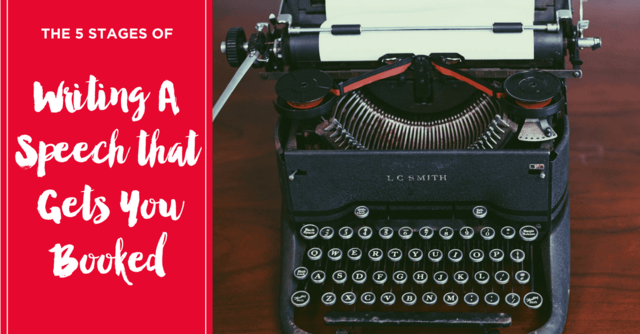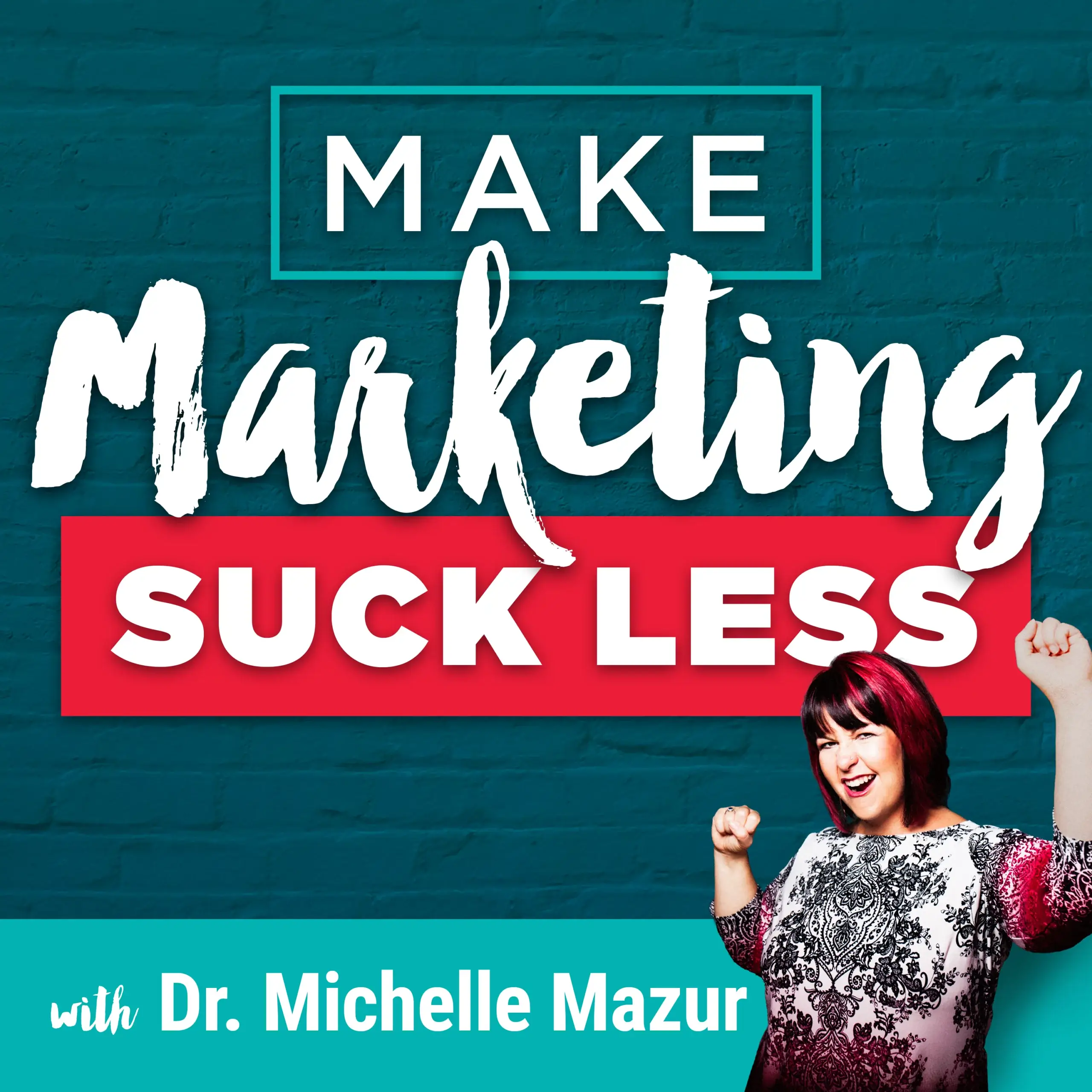Make Marketing Suck Less
The 5 Stages of Writing a Speech that Gets You Booked to Speak
By Michelle Mazur > May 2, 2017
Filed Under Craft Your Signature Talk

Your speech is not a speech. It's your next best-selling product.
That's the strategy that I outlined in my book Speak For Impact.
It's one of the core pillars of building a successful, thriving speaking business. It's one of the things that you should be focusing on whether you're just starting out as a speaker or you're an old pro.
But here is what I see happen all the time in the speaking industry. You create a speech and it's good enough.
It's good enough to get you applause.
It's good enough to get you booked a couple of times.
It might even be good enough to get you a standing ovation and that feels really, really amazing.
It's definitely good enough to get you good enough evaluations.
But what if it could be remarkable?
What if you're leaving money on the table, you're leaving speaking opportunities on the table, you're leaving clients on the table because you're not upgrading your speech to make it truly remarkable?
For the next three posts, we are going to be diving into the lost art of speech writing and how that can make an exponential difference to the bottom line of your speaking business.
I'm going to take you through the five stages of writing a speech that gets you booked to speak and paid.
These are the five stages that I use when I'm working with a client, whether they are starting from scratch in writing a speech or are optimizing something that they have already written and used.
These stages work and they will make for a better product. If you want to go through these stages with me, you can always apply for a strategy session at Drmichellemazur.com/speak and we'll talk about your speaking and how to take your speech and your message so that you get on the stages you want to be on and get paid.
So let's talk about these five strategies.
Prefer to listen?
Table of Contents
Stage 1: Speaking Strategy
The first phase will be familiar to you if you have listened to my podcast before – this is the strategy phase.
For me, this is the key to making sure that you're on the path to a truly remarkable speech and that you're on a path to a successful speaking business.
In this phase, it's all about curiosity. First, you're going to get curious about the audience and figuring out what they actually need from you. When they walk through the door, they are not blank slates. They are looking to you as the speaker to give them some insight into their life.
So how are you going to do that? What do they need from you? When you figure out what they need from you, you can start getting curious about the places or the organizations or the associations and figure out why they would hire you for that message.
Because sometimes, what your audience needs from you and why you get hired are two different things. From a strategy perspective, this helps you build around that knowledge, which makes writing your speech, and crafting the related sales conversations so much easier.
The final part of the strategy is developing what I used to call the big idea. I have begun to rethink that name because I don't think it needs to be all that big. I'm calling this now the anchoring idea. This is essentially the message that you want to be known for. It positions you as a speaker in the marketplace and helps you get known for what you do. It is also the anchors your speech because that is the direction you are steering your speech toward. The anchoring idea is the transformation. It is where you want the audience to end up. You want them to end with your idea.
Stage 2: The Audience Journey
Once we have a firm strategy in place, it is easy to move to Stage 2 and map out we the audience's' journey. This is where it gets messy.
It's time to get down and dirty because you're an expert! You have a ton of ideas about your topic floating in your head. There are multiple ways that you can get the audience from the #1 challenge they face to your anchoring idea.
The first step is to do a brain dump. It doesn’t matter if you do it on post-it notes, in mind mapping software, or through making big lists (this is what I do!) but just get those ideas out of your head.
Having all the stories you could tell or the research you could site at your fingertips allows you to sort through it and then map the best journey that your audience can take.
Since there are multiple routes, you might create multiple maps but at the end of the day, you will want to settle on three to five main points.
You don’t want more than that because otherwise, your speech is going to be too long. You'll have these three three or five points that you're going to be taking the audience through and that's going to make up 80% of your speech. This is the meat of your speech.
Once you have got the basic outline and where we're taking the audience, you have your map. Now the fun starts.
Stage 3: Writing the SFD
In Stage 3 we begin actually writing with the SFD, shitty first draft. This is a term that comes from Anne Lamott, her book Bird by Bird is all about writing. This is the perfect term to describe this part of the process. Because you're going to get even messier.
Your goal with creating this SFD is to go for the D plus version of your speech. You want to start writing it out or outlining it in more detail or creating a PowerPoint, however you best write, it's totally up to you.
But this draft is not about perfection – which is so hard for a lot of my clients because my clients are high achievers. They are so amazing and they really want to get it right. But there is no right. There is just D plus and crappy. So that's what you're going for.
The most important rule that comes into effect right now is that when you are writing this SFD, no editing. You cannot write and edit at the same time. We will get to editing very shortly. It's a very important part of this process but right now – no editing. So get that SFD out onto paper, into PowerPoint or however you're creating this product but just get it out there.
Once you have that, you can move to phase number four and start crafting the beginning and ending of the speech.
Stage 4: The Alpha & the Omega
Now, you might be thinking I'm kind of crazy. Why wouldn't I tell you to write the intro first then write the rest of the speech and then do the conclusion?
The reason I have people do the intro and conclusion together is because they are the two most important parts of the speech. The intro is where you get buy-in from the audience. You grab their attention. You set their expectations. You get them to trust and connect with you. The conclusion is where you give them their marching orders. It's where you give them something to remember you and your speech by.
Research shows that through the primacy-recency effect that these are the two most memorable parts of the speech. They are the most commonly remembered parts of any speech.
Also, frankly, I do it because of practicality.
Writing an opening line is probably the hardest part of the speech writing process. I am not joking. You can spend hours finding it, or you can get lucky and it comes really quickly – but either way, it is the all-important line of your speech. It doesn’t make sense for people to get stuck here – so I advise my clients to write their crappy draft and get it out. Then once they have that, then write that beginning and ending.
Stage 5: The Magic of Editing
Now we get to the fifth phase of speech building: adding the shine. You can think about it as polishing, editing or how I like to think about it, this is where the magic happens.
Unfortunately, a lot of people don't spend enough time in this phase. Sure, they'll polish up their SFD a little bit. They'll make it a little bit better, make sure they have transitions. But there's something truly magical that happens when you start playing with the words and with the stories because editing is the place where a connection will happen with your audience. It's where engagement happens. It's where curiosity about your topic happens. It's where that hunger to want to know more about you and what you do happens.
You can't create any of that magic until you get that SFD out of you and start the editing process.
Stage five is something you will revisit again and again and again in your speech writing. It is important to spend time here. (Sneak Peek! Next time I will tell you what to look for in that editing process.)
So there you have it, those are the five phases that I use with all of my clients when we are either writing a signature talk from scratch or we're going through and optimizing their talk.
If you would like my eyes and this process for your own speaking business, then apply for a strategy session. We'll have a great conversation about your speaking goals, how we can get your speech to a whole other level so that you're not leaving money on the table and you can apply for that at drmichellemazur.com/speak.
Until next time. Use these five stages to write your speech, to optimize and edit your speech. When you use the structure, it will make speech writing far easier and more effective for you and for your audience and for the people who hire you.
Create Your One-of-a-Kind Message
Your 3 Word Rebellion is the Key to Growing Your Business & Impact






